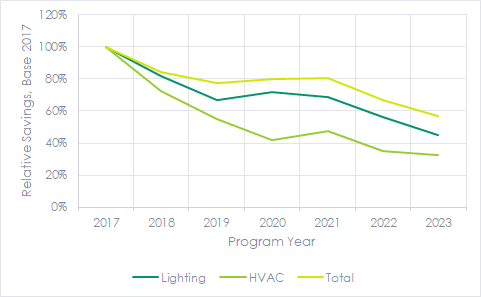
I have detected a pattern unfolding across multiple large energy efficiency portfolios: commercial and industrial prescriptive programs are struggling mightily. Why is this? My hypothesis was that we cycled through two or three rounds of lighting upgrades:
- From T-12 lamps and magnetic ballasts to T-8 lamps and electronic ballasts
- From once ubiquitous A19 incandescent bulbs to buzzing and dim compact fluorescent
- To mainstream and end-of-the-road (or world, if reaching goals is life or death) A19 LED bulbs and linear fluorescent lamps
Lighting has endured for thirty-plus years for three reasons. First, it’s visible and a simple technology. How many “How many __ does it take to screw in a light bulb(?)” jokes can we stand? It’s more complicated than that, of course, but it isn’t a dedicated outdoor air system with chilled beams and radiant perimeter heating with a ground loop heat pump HVAC system. Such an HVAC system is complex and interactive and takes giant leaps of faith from designers and customers alike.
Second, 80-90% of lighting reduces peak load. It’s burning when peaks, at least historical summer peaks, are experienced.
Third, unlike many technologies, like certain electrification applications, LEDs come with huge non-energy benefits in the form of reduced maintenance. LEDs last a very, very long time, and therefore, labor to replace lamps is reduced by 50-70%.
Energy Codes Through The Years
I pulled data from ASHRAE 90.1 – Energy Standard for Buildings Except Low-Rise Residential Buildings, which is invoked directly by state and local governments or indirectly through the International Energy Conservation Code (IECC), which is based on the Standard. The IECC is part of a broader suite of codes from the International Code Council, including Building, Fire, Mechanical, and Plumbing codes. What about electrical? Apparently, they haven’t been able to strike a deal with the National Fire Protection Association, which publishes the National Electrical Code.
For this analysis, I selected some common lighting applications, such as offices and classrooms, and logged lighting power densities (watts per square foot) over time, using 1999 as the base year. The lighting power allowed by energy codes has declined by about 50% in the last 25 years.
 Next, I looked at percent reductions for these applications and the overall estimate published by ASHRAE. Not surprisingly, the overall code declines at a steadier rate, likely because of diverse technologies: HVAC, lighting, envelope, etc. Interestingly, the overall code surged ahead of lighting from 2007 to 2013, and then lighting plunged below the overall code with the 2016 edition. I would say that is rapid LED technology development.
Next, I looked at percent reductions for these applications and the overall estimate published by ASHRAE. Not surprisingly, the overall code declines at a steadier rate, likely because of diverse technologies: HVAC, lighting, envelope, etc. Interestingly, the overall code surged ahead of lighting from 2007 to 2013, and then lighting plunged below the overall code with the 2016 edition. I would say that is rapid LED technology development.
 In that sense, energy codes and standards follow technology development rather than driving it. I don’t remember lighting manufacturers, say Philips or Sylvania, complaining that efficiency standards would drive up prices. Conversely, contractors, especially homebuilders, complain, warn, or inform that more stringent codes and standards push higher costs.
In that sense, energy codes and standards follow technology development rather than driving it. I don’t remember lighting manufacturers, say Philips or Sylvania, complaining that efficiency standards would drive up prices. Conversely, contractors, especially homebuilders, complain, warn, or inform that more stringent codes and standards push higher costs.
Code Impacts On Portfolio Savings
What are the impacts on portfolios? The chart below shows energy savings achieved by one large utility’s portfolio, including lighting, HVAC, and overall, using 2017 as the base year. Ten or twenty percent savings with a small denominator (baseline) doesn’t add up like it used to, while the effort and technology development required for each percentage point saved remains the same or gets even more challenging.
 I explored this trend with a statistically insignificant but close-to-the-ground and knowledgeable group of program implementers. The message I heard is plenty of opportunity remains. Still, barriers include contractors who only want to work in specific neighborhoods with limited technologies and customers whose minds are complex to change. They may not like the utility, which isn’t uncommon in some areas. I said yes, it’s like muskie fishing. The fish may be visible on sonar, and you can hit them on the head with a 10-inch swimbait, but they are only annoyed by your silly game.
I explored this trend with a statistically insignificant but close-to-the-ground and knowledgeable group of program implementers. The message I heard is plenty of opportunity remains. Still, barriers include contractors who only want to work in specific neighborhoods with limited technologies and customers whose minds are complex to change. They may not like the utility, which isn’t uncommon in some areas. I said yes, it’s like muskie fishing. The fish may be visible on sonar, and you can hit them on the head with a 10-inch swimbait, but they are only annoyed by your silly game.
Program Adaptations
How does a portfolio overcome these changes? Adapt, of course. The price of everything has increased. Big Mac combo meals top out at $18. Eight. Teen. Dollars! In another up-close example of a burger, fries, and a Coke, try Five Guys at $23! And here I was complaining that I couldn’t get a decent burger for less than $20 after returning from a recent business trip. Last month, I picked up a three-piece chicken strip basket from A&W for my mother (one of her favorites). $11.48! Food isn’t energy efficiency, but these prices are rolling through everything. I will write more on this next week. The bottom line is the cost of energy savings is anchored to the year 2000. That must change. Meanwhile, the price of electricity is up 30% since 2021.
Getting contractors and outreach folks to engage with communities that have been underrepresented or have low participation for whatever reason is going to cost more. There is a reason they are underrepresented or not engaged. They may need a bigger buydown (incentive), or new tactics must be tested and perfected. Program administrators want more penetration but without more outreach and face time. That math doesn’t work.
Second, portfolios must pivot to larger, longer-term programming and customer engagements. I used to use terms like “ambulance chasing” or “dropping money from helicopters” to describe free riders (I can get you money for that—what?) or lightbulb giveaways, respectively. Those sorts of measures and lighting retrofit/replacements from easy-to-access customers are rapidly drying up, causing pain in prescriptive programs.
I suggest a strong portfolio of strategic energy management programs to engage with customers over the long term: 2-4 years to infuse energy management into the culture and then less frequent check-ins thereafter. A strong SEM program continuously feeds prescriptive, custom, retro-commissioning, and even new construction projects. It is a flagship program.
These strategies and tactics will succeed but require a (to use a golden oldie) paradigm revolution.
